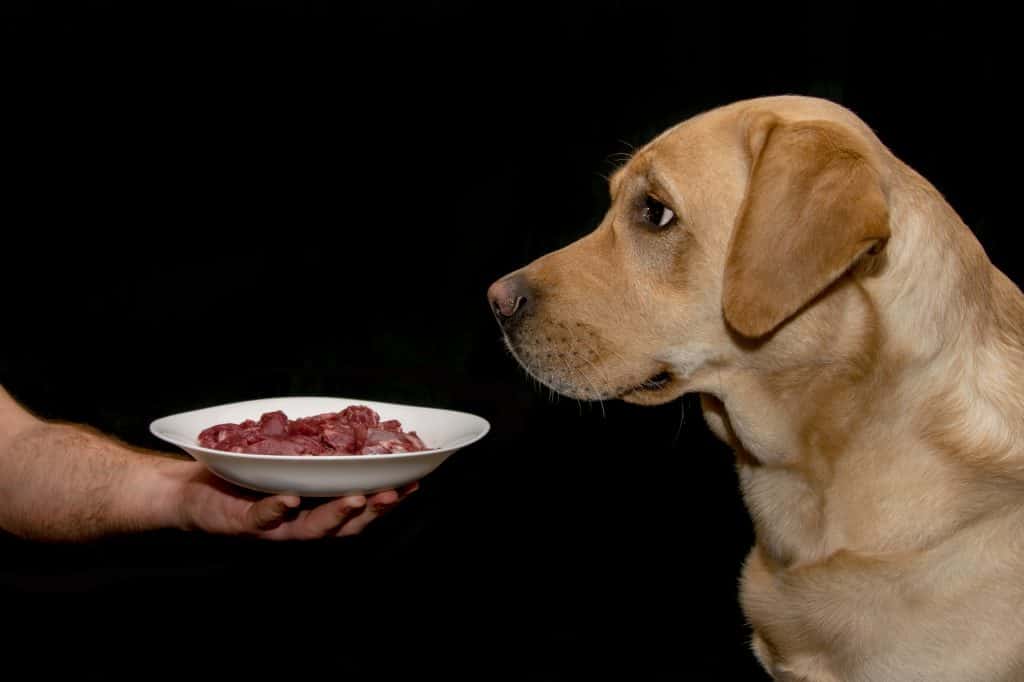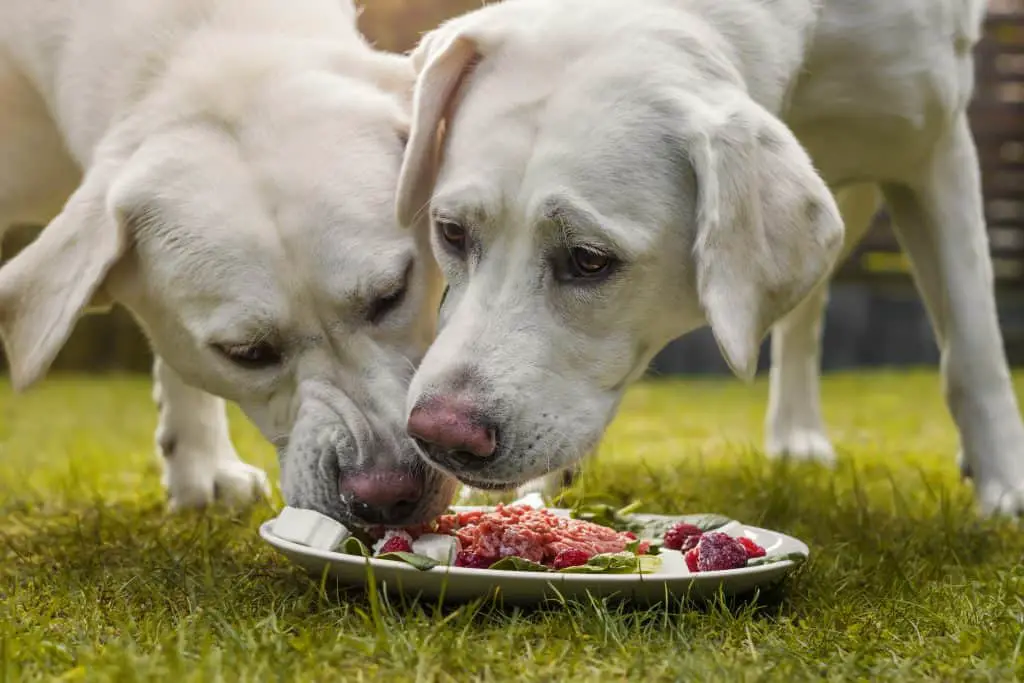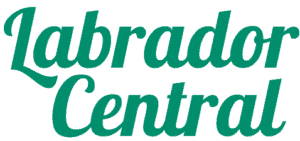
We all want the very best for our dogs, starting by giving them the nutrition possible. Raw food diets have grown in popularity as of late. This diet focuses on returning your dog to its ancestral diet of meat and bones. But can Labradors eat raw meat? In this article, we’ll dive into what constitutes a raw food diet and if it’s the best option for your Labrador.

Can Labradors Eat Raw Meat?
According to some animal experts, the answer is yes. As you know dogs are descended from wolves, who survive in the wild by eating the raw meat and organs of their prey.
Proponents of the raw diet argue that Dogs are designed by nature to eat raw meat. However, one could argue that the digestive system of dogs has changed with millennia of domestication and that it is now very different from that of wolves. Also, the meat that wolves eat in the woods is very different from what we can buy in the supermarket to feed our dogs. When wolves consumed prey in the wild, they are eating it fresh. Now meat goes through a whole process: being packaged, shelved, maybe even frozen.
While your dog does have the ability to eat raw meat, the FDA advises against it. They state that it puts both your dog and your family at risk for contracting bacteria found in raw meat like Salmonella. Should you choose to feed your dog a raw diet, it’s highly suggested that you consult with the FDA safety guidelines. It’s important to gain knowledge of raw feeding and all of the pros and cons before diving in. The easiest and safest way to feed your dog raw food is to find a supplier of specially prepared raw diets called BARF.
What is a Dog Raw Diet or BARF
The acronym BARF is not something you would typically happily associate with food. Australian-born vet, Ian Billinghurst, coined the acronym in 1993. BARF means Biologically Appropriate Raw Food or in other words Bones and Raw Food. Billinghurst proposed the idea of returning your dog to its primal diet which consists of raw meat, bones, and uncooked vegetables. Notice there are not any grains included in BARF. That’s on purpose.
There is also the RMB diet which stands for “raw meaty bones.” It’s also known as the Prey Model. The main difference between the two is that BARF contains vegetables. RMB does not. Rather than including vegetables, this model requires that dogs consume green stomach tripe as a way to ingest nutrients. BARF, on the other hand, includes ground-up or pureed vegetables in an attempt to replicate the nutrients found in the stomach of their prey.

Components of a raw food diet:
-Muscle meat and organ meats like liver or heart.
-Bones with the muscle meat still attached
-Vegetables like carrots and broccoli
-Fruit
Pros and Cons of Raw Dog Food
The raw dog food diet hasn’t been around long enough for research to support it’s being beneficial. However, those who do choose to follow this diet swear by the benefits. We’ll break down some raw dog food pros and cons in an attempt to shed some light.
Pros of Raw Dog Food
-Potentially alleviate old age symptoms like joint inflammation
-Shiny and silky coat
-Cleaner teeth lead to better breath
-Smaller and healthier stool/healthier anal glands, which helps to eliminate stool odor.
-Higher energy levels
-Less bloat due to the lack of grain
-You can make it yourself
Cons of Raw Dog Food
-Potential unbalanced nutrition, which can ultimately damage health.
-Nutritional deficiencies can lead to weak bones and thin coats among other issues.
-Potential to choke on bones.
-Broken teeth from chewing on bones.
-Internal punctures from bone shards.
– It’s not good for dogs with kidney disease due to the high protein content.
-A potential lack of calcium and phosphorous can cause bone deformities in puppies.
-Potential to spread bacteria like Salmonella throughout the home posing risk to themselves and humans.
-It can be expensive.
While the positives of using a raw food diet do seem attractive, the list of cons seems to be concerning. Overall, the main issue is the lack of nutritional balance in the diet of dogs. It just requires paying more attention to make sure all necessary vitamins and minerals are accounted for in your dog’s diet. Be realistic if this is something you can devote your time to or not.

Feeding Your Labrador a Raw Diet
First and foremost, take note that it’s important to vary the kinds of meat you’re feeding your dog. Different sources contain different vitamins and minerals. Rotating meat sources helps to ensure a healthy nutritional balance. A main component of the raw diet is bone consumption. The muscle meat should still be attached to the bone when feeding your dog. Please take note, do not feed your dog cooked bones. Cooking makes them brittle and has potential choking hazards. In an attempt to avoid broken teeth, be selective in which bones you give your dog. Avoid bones that bear a significant amount of weight. Leg bones for instance in cattle have a high reputation for breaking teeth.
If you’re serious about adopting a raw diet, stop giving your dog bones for fun. Bones are now part of a meal. Also, do not cut up the meat or attempt to break the bones into smaller chunks. This only creates potential choking hazards. Your dog will instinctively break everything up naturally. Furthermore, you have a few other things to consider when switching to a raw diet. For instance, where will you feed your dog? This diet is messy and not something you’ll want to clean up every day. If it’s possible, feed your dog outdoors. If you live in an apartment or if there is inclement weather, lay out a washable sheet or rug to protect the surfaces in your home. Similarly, think about storage. Most people buy in bulk because it saves time and money. Do you have room in your freezer? You’ll also want to set aside a place to defrost.

Transitioning From Kibble to Raw
If your dog has any preexisting health conditions, consult with your veterinarian first. If your vet says it’s ok, start by introducing your dog to a cooked homemade diet first. Get the medical issues under control before switching over to raw. Once you’ve established your dog is ready for a raw diet, gradually begin introducing different foods every three days. This gradual process allows you to discern if your dog has any food allergies or intolerances. If they become sick or bloated after the introduction of an ingredient, simply eliminate it from their diet.
RELATED POST: A GUIDE TO WHAT TO FEED YOUR LABRADOR PUPPY
Natural Healthy Alternatives to the Raw Diet
When relying on a raw diet, owners take a risk of potentially giving their dogs unbalanced nutrition. To be safe and responsible, consult with a vet before and during the process. Some alternatives have the same benefits as a raw food diet, as well as consistent nutritional content.
The first alternative is Freeze-Dried Raw Meat. This is meant to be used in combination with traditional kibble, as a way to supplement the dog’s diet with real meat. Freeze-Dried Raw Meat usually contains up to 95 percent muscle meat, ground bone, and organ meat. The other 5 percent is made up of raw or lightly processed ingredients. As a bonus, freeze-dried raw meat has a significantly longer shelf life than average kibble. The average moisture content of freeze-dried meat is typically around 5 percent. This low moisture content prevents food from spoiling prematurely. Take note that this dog food is still raw.
Another option is Biological Appropriate Kibble, this sounds like a very scientific name. However, the term just means that it’s suitable for the designated species. In this case, dogs. Biological Appropriate Kibble is designed to meet the specific nutritional needs of dogs. This means that the food has been made with the same type of meat, vegetables, bones, and fruits that would be found in the BARF diet, but in the form of dry food. This makes it nutritionally superior to dry dog food typically sold in supermarkets. This method of feeding is perhaps the easiest to ensure nutritional balance.
Finally, there is fresh dog food. Like BARF food, fresh food is made with natural ingredients that promote a balanced and healthy diet in dogs, such as: such as beef, chicken, and lamb, vegetables such as peas, spinach, carrots, and fruits such as blueberries, among others. The main difference between fresh food and the BARF diet is that fresh food is not raw, which reduces the potential risks of contamination with bacteria that are harmful to health and do not need to be frozen.
Click here to find the best Fresh Dog Food and High-quality Kibble for your Labrador
Conclusion
While a raw diet might seem like a fun and easy trend, it’s quite labor-intensive. If you’re planning to incorporate a raw diet into your dog’s life, first consult with your vet. They may have words of wisdom, or they may beg you to reconsider. Regardless, remember your choice is ultimately up to you. If you have the time and effort to put into feeding your dog a raw diet, then why not? However, if you have a busy lifestyle, start with one of the alternative suggestions like biologically appropriate kibble. All in all, ensure that your Labrador is happy and feeling good. That’s truly what is most important.
If you want to find the best pet insurance for your labrador, click here


